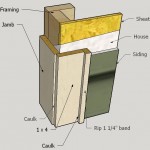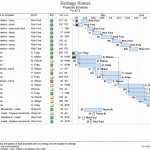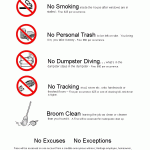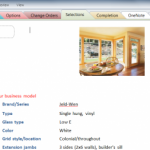Performance Standard: HBR articles 13-1 to 13-5, 14-2 Click icon to view book 
Circuit breakers shall not be triggered by normal usage. The builder will check wiring circuits for conformity with applicable national, state, or local electrical code requirements.
The builder will correct circuitry not conforming to applicable code specifications.
Warranty period: 2 years
GFIs and APIs; Ground fault interrupter (GFI) and arc fault interrupter (API) are code required safety devices installed as part of the electrical system to provide protection against electrical shock. These sensitive devices can be tripped very easily.
The builder will install ground fault interrupters and/or arc fault interrupters in accordance with approved electrical codes. Tripping is to be expected and is not covered unless the devise is deemed by defective.
Warranty period: 2 years
Electrical outlets and switches shall operate as designed.
The builder will repair or replace malfunctioning electrical outlets and switches if supplied and installed by the builder.
Warranty period: 2 years
Electrical outlets and switches in junction boxes on exterior walls may allow cold air to flow through or around an outlet into a room. It may not be possible to eliminate this completely.
Warranty period: NONE
Light fixture (interior or exterior) and/or ceiling fan malfunctions or finish failures may be covered by the manufacture’s warranty.
Warranty period: NONE
Homeowner Operation and Maintenance
You should know the location of the breaker panel box (garage or basement); it includes a main shut-off that controls all the electrical power to the home. Individual breakers control the separate circuits. Each breaker is marked either specifically or vaguely to help you identify which breaker is connected to which major appliances, outlets, or other service. Should a failure occur in any part of your home, always check the breakers in the main panel box.
Breakers – Most circuit breakers have three positions: on, off, and tripped. When a circuit breaker trips, it must first be turned off before it can be turned on. Switching the breaker directly from tripped to on will not restore service. (upload and link to picture)
Breakers Tripping – Breakers trip because of overloads caused by: plugging too many appliances into the circuit, a worn cord, defective appliance, or operating an appliance with too high a voltage requirement for the circuit. The starting of some electric motors can also trip a breaker.
If any circuit trips repeatedly, unplug all items connected to it and reset the breaker. If it trips when nothing is connected to it, you need an electrician. If the circuit remains on, one of the items you unplugged may be defective.
Buzzing – Fluorescent fixtures use transformer action to operate. This action sometimes causes a buzzing.
Light fixtures may buzz if they are operated by a dimmer switch that is not in the full ’ON’ position.
GFCI (Ground-Fault Circuit-Interrupters) – GFCI receptacles have a built-in element that senses fluctuations in power. Quite simply, the GFCI is a circuit breaker. Building codes require installation of these receptacles in bathrooms, the kitchen, outside, and the garage (areas where an individual can come into contact with water while holding an electric appliance or tool). Heavy appliances such as freezers or power tools will often trip the GFCI breaker.
Caution: Never plug a refrigerator or food freezer into a GFCI-controlled outlet. The likelihood of the contents being ruined is high and the limited warranty does not cover such damage.
Each GFCI circuit has one outlet with a test and reset button. Find the location of your GFCI test outlets in bathrooms, kitchen, garage and basement. Once each month, press the test button. This will trip the circuit. To return service, press the reset button. If a GFCI breaker trips during normal use, it may indicate a faulty appliance and you will need to investigate the problem. One GFCI breaker can control up to four outlets. (upload and link to picture)
AFCI’s (Arc Fault Circuit Interrupters) have been installed in your house. The ‘reset’ button is typically located on the breaker governing the circuit in question. This safety device turns power off to the outlet if an arc or spark is generated between the outlet and appliance plug being used (lamp, TV, computer, battery charger, etc).
Light Bulbs – You are responsible for replacing burned-out bulbs.
Modifications – If you wish to make any electrical modifications during the warranty period, contact the electrician listed on the Contractor Phone Numbers list you receive at the final walk through. Having another electrician modify your electrical system during the warranty period will void that portion of your limited warranty.
Outlets – If an outlet is not working, check first to see if it is controlled by a wall switch, GFCI or AFCI. Next, check the breaker.
If there are small children in the home, install safety plugs to cover unused outlets. This also minimizes the air infiltration that sometimes occurs with these outlets. Teach children to never touch electrical outlets, sockets, or fixtures.
Smoke/Carbon Monoxide Detectors – If a detector makes a chirping sound that is a sign that the battery needs to be replaced. Most detectors use a 9 volt battery. See user’s manual for more information/create flipbook of manual and link it here if desired.
For your safety, clean each detector monthly to prevent a false alarm or lack of response in a fire. After cleaning, push the test button to confirm the alarm is working.
Smoke/carbon monoxide detectors are installed in accordance with building codes, which dictate their locations. You should not remove or disable any of the detectors in your home.
Underground Cables – Before digging, check the location of buried service leads by calling UFPO (Underground Facilities Protection Organization) at 800-962-7962. In most cases, wires run in a line from the service panel to the nearest public utility pad.
No Electrical Service Anywhere in the Home
Before calling for service, check to confirm that the;
- Service is not out in the entire area. If so, contact the utility company.
- Main breaker and individual breakers are all in the on position.
No Electrical to One or More Outlets
Before calling for service, check to confirm that the;
- Main breaker and individual breakers are all in the on position.
- Applicable wall switch is on
- GFCI or AFCI is set (see details earlier in this section)
- Item you want to use is plugged in
- Item you want to use works in other outlets
- Bulb in the lamp is good
Even if the troubleshooting tips do not identify a solution, the information you gather will be useful to the service provider you call.
An Electrical emergency is: Total loss of electricity
Greener Living Tips
Light Bulbs – If you’re going to do just one thing for the planet, make it the switch to compact fluorescent light bulbs (CFLs). Although they cost several times more upfront than regular incandescent light bulbs, they also last about 10 times longer, which means that for every CFL you screw in, you’ll be saving eight incandescent light bulbs from landfill purgatory. Plus, you’ll save some serious cash in the long run. Because CFLs use 75 percent less energy, swapping one incandescent bulb for a CFL reduces carbon dioxide by 500 pounds a year; replacing 17 has the equivalent effect of taking one car off the road for a year. Just remember to recycle spent bulbs responsibly – CFLs contain trace amounts of mercury, which although isn’t enough to be hazardous to you, could pose a problem in landfills when mercury from multiple bulbs leaches into the ground.
Energy Eaters – You may not know it, but households across the globe are infested with Energy eaters. Cleverly disguised as innocuous household appliances (your television is one of them), their three prongs plunge into your wall outlets, draining power all hours of the day and night, even after you’ve switched them off. (Americans pay $1 billion a year to power our televisions and VCRs while they’re turned off.) Other sleeper agents of the electric undead that consume 1,000 kilowatt hours a year per household, while in standby mode: your toaster, coffeemaker, hair dryer, PC, printer, cable box, and cell phone charger.
You don’t have to live in a constant state of fear; forever checking behind your back for that one appliance you forgot to pull the plug on. Just plug adjacent equipment into power strips with surge protectors, and before you crawl under the safety of your covers-or head out to work-simply flip the switch.
BUILDER Limited Warranty Guidelines
During the final walk through, we confirm that light fixtures are in acceptable condition and that all bulbs are working. BUILDER’s limited warranty excludes any fixtures or bulbs you supplied.
Designed Load – BUILDER will repair any electrical wiring that fails to carry its designed load to meet specifications. If electrical outlets, switches, or fixtures do not function as intended, BUILDER will repair or replace them within the warranty period.
GFCI (Ground-Fault Circuit-Interrupters) – BUILDER is not responsible for food spoilage that results from plugging refrigerators or freezers into a GFCI outlet.
Power Surge – Power surges are the result of local conditions beyond the control of BUILDER and are excluded from limited warranty coverage. These can result in burned-out bulbs or damage to sensitive electronic equipment such as TVs, alarm systems, and computers. Damage resulting from lightning strikes is also excluded from limited warranty coverage.










